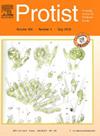显然被误解的阿尔方斯·穆尼耶的巨型Didinium
IF 2.1
3区 生物学
Q4 MICROBIOLOGY
引用次数: 0
摘要
Meunier的《Microplankton des Mers de Barents et de Kara》是第一本关于北极浮游生物原生生物的专著,它包含了许多不同分类群的新物种的描述。其中最引人注目的是一种纤毛虫,以大写字母G命名,与拉伯雷1534年出版的法国文学经典小说《巨人》中的主人公——贪吃的巨人相对应。Meunier在文章中详细地描述了d.g argantua是一种巨大的贪婪的捕食者,并为它描绘了许多人物。时至今日,据报道,海洋和河口生态系统的多样性令人惊讶,例如,从南极海冰到墨西哥湾、切萨皮克湾和里海。然而,大多数报告涉及的标本尺寸比Meunier描述的大多数标本要小得多,并且没有引用分类学权威来鉴定纤毛虫,这表明许多研究人员可能不熟悉Meunier 1910年的专著,因此不熟悉他的“巨型”性质的d.g argantua。在这里,首先给出默尼耶的简短传记,然后是对他1910年专著的描述,然后是对他的文本的总结,以及他的一些引人注目的D. gargantua。最后,回顾了后来关于D. gargantua发生的报道,认为许多报道涉及一个与D. gargantua不同的物种,因为与Meunier的物种相比,它们在大小和形状上存在很大差异。本文章由计算机程序翻译,如有差异,请以英文原文为准。
The apparently misunderstood Didinium Gargantua of Alphonse Meunier
Meunier's, 1910 “Microplankton des Mers de Barents et de Kara” was the first monographic treatment of protists of the arctic plankton, and it contained many descriptions of new species of a variety of taxa. Among the most conspicuous was the ciliate Didinium Garantua, named with a capital G, corresponding with the title character, the gluttonous giant, of Rabelais' 1534 novel, Gargantua, a classic of French literature. Meunier described D. gargantua at length in the text as a large voracious predator, and devoted many figures to it. As of today, it has been reported from a surprising diversity of marine and estuarine ecosystems, for example, from Antarctic sea-ice, to the Gulf of Mexico, the Chesapeake Bay, and the Caspian Sea. However, most reports concern specimens of sizes considerably smaller than most of those depicted by Meunier, and cite no taxonomic authorities for ciliate identifications, suggesting that many researchers may be unfamiliar Meunier's, 1910 monograph, thus with the ‘gargantuan' nature of his D. gargantua. Here, a brief biography of Meunier is given first, followed by a description of his 1910 monograph, and then a summary of his text, and some of his remarkable figures of D. gargantua are presented. Finally, subsequent reports of the occurrence of D. gargantua are reviewed, and it is suggested that many concern a species distinct from D. gargantua, as there are large differences in size and shapes compared to Meunier's species.
求助全文
通过发布文献求助,成功后即可免费获取论文全文。
去求助
来源期刊

Protist
生物-微生物学
CiteScore
3.60
自引率
4.00%
发文量
43
审稿时长
18.7 weeks
期刊介绍:
Protist is the international forum for reporting substantial and novel findings in any area of research on protists. The criteria for acceptance of manuscripts are scientific excellence, significance, and interest for a broad readership. Suitable subject areas include: molecular, cell and developmental biology, biochemistry, systematics and phylogeny, and ecology of protists. Both autotrophic and heterotrophic protists as well as parasites are covered. The journal publishes original papers, short historical perspectives and includes a news and views section.
 求助内容:
求助内容: 应助结果提醒方式:
应助结果提醒方式:


